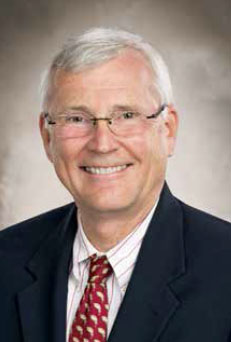Breadcrumb
Alum Stephen Streed Shines Light on Infection Prevention
By Cindy Hadish
Published on June 2, 2014
Keeping patients safe from health care-associated infections (HAIs) is a major part of every hospital’s mission, and recent data from the CDC show that progress is being made nationally. However, there’s still room for improvement: On any given day, about 1 in 25 U.S. hospital patients acquires an infection while receiving medical care, adding up to about 722,000 infections in 2011, the CDC reports. About 75,000 patients with HAIs died during their hospitalizations.

CPH alumnus Stephen Streed (MS in Preventive Medicine and Environmental Health ʼ75) has worked in the field of hospital epidemiology for more than 35 years. With new challenges always on the horizon, he sees the front lines of infection control as a battle zone that calls for both tried-andtrue techniques and cutting-edge technology.
Streed embraces both approaches as system director of epidemiology/infection prevention at Lee Memorial Health System in Fort Myers, Fla. Keeping infections at bay in Lee Memorial’s four hospitals requires vigilance not only from Streed’s staff of 11, but the entire workforce of 15,000.
Current Challenges
“There’s been quite a movement toward environmental hygiene,” Streed says of the cleaning and sanitation processes used in infection control. “It’s become more important now than in the past.”
Patients are now most likely to get infections at the site of surgery and in the lungs, as well as in the bloodstream, the urinary tract, and the gut. The most common germs causing HAIs are C. difficile; Staphylococcus aureus, including MRSA; Klebsiella; E. coli; Enterococcus; and Pseudomonas.
Infection control experts like Streed have led recent improvements in managing many of these bugs in hospitals. As one infection control method, Streed says health care workers are able to screen patients for the presence of MRSA. Patients who carry MRSA can be given daily baths with an antibacterial soap called chlorhexidine gluconate. The antiseptic has been shown to reduce the risk of hospital infections in patients, Streed says.
C. difficile, which causes severe diarrhea, remains at high levels, according to the CDC. The elderly, especially those who take antibiotics, are most at risk. C. difficile can be difficult to control since spores from infected patients are released into the environment and can last weeks or even months, “like tiny seeds waiting to germinate,” Streed says. Additionally, several years ago a mutation resulted in a more pathogenic strain.
The New and the Old
One of the newest sanitation methods capturing attention, as well as praise, from Streed and his colleagues are portable units that emit ultraviolet (UV) light. The devices work in about 15 minutes to sterilize nearly everything in the room where they are positioned.
Most of the UV radiation that reaches the Earth is ultraviolet A, Streed explains, the type that causes sunburn. The UVC rays used in the technology disrupt microorganisms’ DNA, causing them to die. Because the wavelength does not penetrate, its use doesn’t deteriorate plastics or other materials. “There are very few downsides,” he says.
One issue, however, is cost; the devices range from $30,000 to $100,000, but Streed compares that to the expense of a serious post-operative wound infection at $50,000 or more. “So the investment upfront is worth it,” he says.
Machines that spray hydrogen peroxide vapors provide even better “killing” effects, according to tests, Streed says, but are more complicated to use, requiring air returns to be blocked and air scrubbers to remove residual hydrogen peroxide.
Another basic form of infection control—hand hygiene—is garnering renewed attention. “It’s not taken for granted at all,” Streed says, noting that Lee Memorial has brought its hand hygiene compliance rates to above 90 percent, while the national norm is 60 to 70 percent. Education on proper hand washing with soap and water and using alcohol-based hand sanitizer is important, as is making supplies readily available for health care workers, visitors, and patients.
A Dynamic Field
Hospitals have added impetus under recently modified Medicare rules that withhold payment for providers that perform at lower levels of efficiency, based on outcomes that include patient satisfaction, complications, and readmission rates. Centers for Medicare and Medicaid Services now withholds a certain percentage of their Medicare reimbursements to hospitals pending performance evaluation. Better performers eventually receive full payment, while underperformers do not; in effect, underperformers are penalized, Streed explains, “so there are financial incentives to doing the right thing.”
Much has changed—including new guidelines, technologies, and disease strains—since he graduated from the UI, which is what keeps Streed, now 65, excited about the field of epidemiology and his role battling infectious diseases. In fact, he’s currently working on a doctoral degree in public health. To Streed, the 2009-2010 H1N1 pandemic demonstrated the interconnectedness of our health care system, and he wanted to broaden his own understanding of the system through formalized studies leading to a DrPH degree.
“This is still a moving and dynamic field,” Streed says. “There is something new almost every day.”